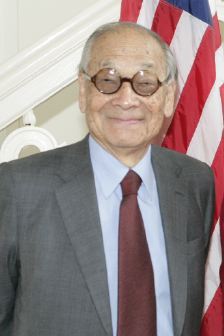
Ieoh Ming Pei was a Chinese-American architect. Raised in Shanghai, Pei drew inspiration at an early age from the garden villas at Suzhou, the traditional retreat of the scholar-gentry to which his family belonged. In 1935, he moved to the United States and enrolled in the University of Pennsylvania's architecture school, but he quickly transferred to the Massachusetts Institute of Technology. He was unhappy with the focus at both schools on Beaux-Arts architecture, and spent his free time researching emerging architects, especially Le Corbusier. After graduating, he joined the Harvard Graduate School of Design (GSD) and became a friend of the Bauhaus architects Walter Gropius and Marcel Breuer. In 1948, Pei was recruited by New York City real estate magnate William Zeckendorf, for whom he worked for seven years before establishing an independent design firm in 1955, I. M. Pei & Associates. In 1966 that became I. M. Pei & Partners, and in 1989 became Pei Cobb Freed & Partners. Pei retired from full-time practice in 1990. In his retirement, he worked as an architectural consultant primarily from his sons' architectural firm Pei Partnership Architects.

L'Enfant Plaza is a complex of four commercial buildings grouped around a large plaza in the Southwest section of Washington, D.C., United States. Immediately below the plaza and the buildings is La Promenade shopping mall.

The Cityplace Tower is a 42-story building located at 2711 North Haskell Avenue at North Central Expressway in the Cityplace district of Uptown Dallas, Texas (USA). The building is 560 feet (171 m) tall and has 1,400,000 square feet (130,000 m2) of office space. It is also the tallest building in Dallas outside of Downtown.
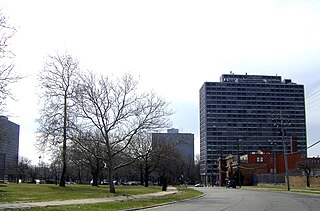
Lafayette Park is an neighborhood located east of Downtown Detroit. It contains a residential area of some 4,900 people and covers 0.07 sq mi.
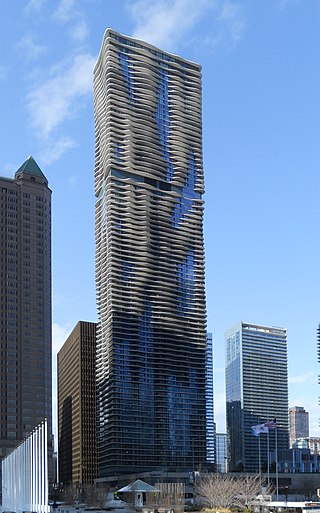
Aqua is an 82-story mixed-use skyscraper in Lakeshore East, downtown Chicago, Illinois. Designed by a team led by Jeanne Gang of Studio Gang Architects, with James Loewenberg of Loewenberg & Associates as the Architect of Record, it includes five levels of parking below ground. The building's eighty-story, 140,000 sq ft (13,000 m2) base is topped by a 82,550 sq ft (7,669 m2) terrace with gardens, gazebos, pools, hot tubs, a walking/running track and a fire pit. Each floor covers approximately 16,000 sq ft (1,500 m2).

The St. James is a luxury residential skyscraper in Washington Square West, Philadelphia, Pennsylvania, United States. The 498 feet (152 m), 45-story high-rise stands along Walnut Street and Washington Square and is the 15th tallest building in Philadelphia.

1700 East 56th Street, also known as 1700 Building, is a 38-story luxury apartment building overlooking Lake Michigan and adjacent to Jackson Park and the Museum of Science and Industry in the Hyde Park neighborhood of Chicago in Cook County, Illinois, United States. Designed by Loewenberg Architects, its construction was completed in 1968, followed by a condominium conversion in 1994. With 369 residences, this was the largest Hyde Park condominium conversion in a decade, when a recession and soaring interest rates halted Chicago's condo conversion frenzy.
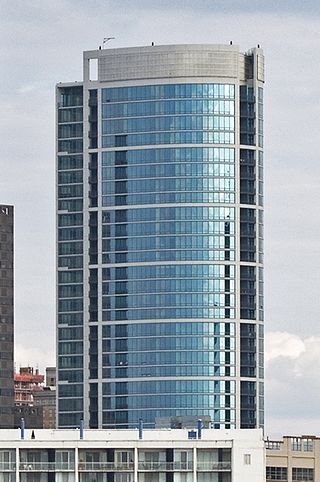
The Murano is a residential skyscraper in Center City, Philadelphia. Part of a condominium boom occurring in the city, the Murano was announced in 2005 and was developed jointly by Thomas Properties Group and P&A Associates. The building, named after Murano, Italy, was completed in 2008 at a cost of US$165 million. The site, previously occupied by a parking lot, was the location of the Erlanger Theatre from 1927 to 1978.

Central Park Place is a residential condominium building in the Hell's Kitchen and Midtown Manhattan neighborhoods of New York City. The building is at 301 West 57th Street, at the northwest corner with Eighth Avenue. Davis Brody Bond designed Central Park Place, which is 628 feet (191 m) tall with 56 stories. Central Park Place's facade is made of gray-green glass and aluminum panels, a color scheme intended to associate the building with the nearby Central Park.

The Corinthian is a 57-story apartment building that was New York City's largest apartment building when it opened in 1988.
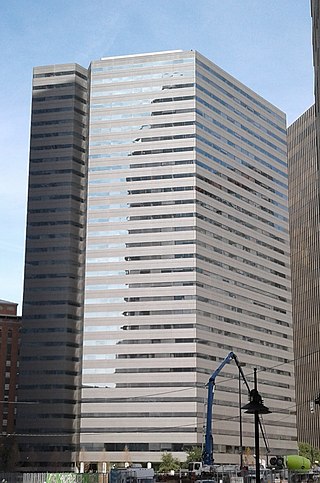
One Dallas Center is a modernist skyscraper located in the City Center District of downtown Dallas, Texas, completed in 1979. The building has 30 floors and rises 448 feet. One Dallas Center is currently tied with the Sheraton Dallas Hotel North Tower as the 25th-tallest building in the city. The building was originally planned as part of a three-building complex designed by I.M. Pei & Partners, but only one tower was constructed.
Magellan Development Group, LLC is an American real estate and property development company that was formed in 1996 as a result of a long term corporate partnership between Joel Carlins and James Loewenberg.

The University Village is a complex of three apartment buildings located in Greenwich Village in the Lower Manhattan-part of New York City. The complex is owned by New York University and was built in the 1960s as part of the university's transition to a residential college. One of the towers, 505 LaGuardia Place, is a co-op that does not house students, and the other two towers, Silver Tower I and Silver Tower II, house faculty and graduate students of NYU. The buildings were designed by modern architects James Ingo Freed and I. M. Pei, and the central-plaza contains a sculpture by Carl Nesjär and Pablo Picasso. In 2008 the complex was designated a New York City Landmark by the Landmarks Preservation Commission.

The Zeckendorf Towers, sometimes also called One Irving Place and One Union Square East, is a 345 ft-tall (105 m), 29-story, four-towered condominium complex on the eastern side of Union Square, Manhattan, in New York City. Completed in 1987, the building is located on the former site of the bargain-priced department store S. Klein. Designed by architectural firm Davis, Brody & Associates, and named in honor of prominent American real estate developer William Zeckendorf, it was one of New York City's most important development projects of the 1980s.
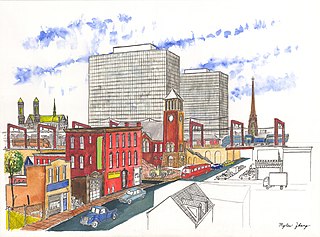
The Pavilion and Colonnade Apartments are three highrise apartment buildings in Newark, New Jersey. The Pavilion Apartments are located at 108-136 Martin Luther King Junior Blvd. and the Colonnade Apartments at 25-51 Clifton Avenue in the overlapping neighborhoods known as Seventh Avenue and Lower Broadway.

Kiryat Wolfson, also known as Wolfson Towers, is a high-rise apartment complex in western Jerusalem. Comprising five towers ranging from 14 to 17 stories above-ground, the project was Jerusalem's first high-rise development. The project encountered opposition from both municipal officials and the public at each stage of its design and construction. The complex includes 10,000 square feet (930 m2) of commercial space and a medical center. The project was financed by the Edith and Isaac Wolfson Trust.
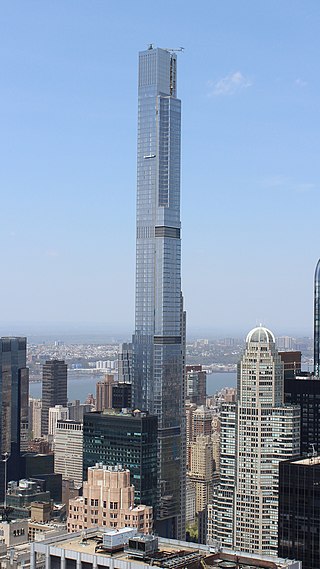
Central Park Tower is a residential supertall skyscraper at 225 West 57th Street in the Midtown Manhattan neighborhood of New York City, along Billionaires' Row. Designed by Adrian Smith + Gordon Gill Architecture, the building rises 1,550 feet (472.4 m) with 98 above-ground stories and three basement stories, although the top story is numbered 136. Central Park Tower is the second-tallest building in New York City, the United States, and the Western Hemisphere; the 15th tallest building in the world; the tallest primarily residential building in the world; and the tallest building outside Asia by roof height.
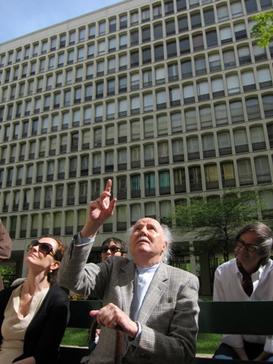
Araldo Cossutta was an architect who worked primarily in the United States. He worked at the firm I. M. Pei & Partners from 1956 to 1973. I. M. Pei has been among the most honored architects in the world. Cossutta was Pei's associate and ultimately his partner in the first phase of Pei's career. He was responsible for some of the firm's best-known designs from that era, including three that have received "landmark" designations in recent years. In 1973 he and Vincent Ponte left Pei's firm to form Cossutta & Ponte, which ultimately became Cossutta and Associates. The new firm designed the Credit Lyonnais Tower in Lyon, France (1977) and the Tower at Cityplace (1988) in Dallas, Texas, among other commissions.

William Zeckendorf Jr. was an American real estate developer. Son of William Zeckendorf Sr., he was the second of three generations of one of New York's great real estate dynasties. While keeping a lower profile than his famously flamboyant father, Zeckendorf Jr. was highly successful in his own right. Like his father, he became known for large-scale projects that transformed neighborhoods.

Sven is a residential building located at 29-59 Northern Boulevard in the Long Island City neighborhood of Queens, New York City. At 762 feet (232 m) tall, Sven is the second-tallest building in Queens behind Skyline Tower, as well as one of the tallest buildings in New York City outside of Manhattan.





















